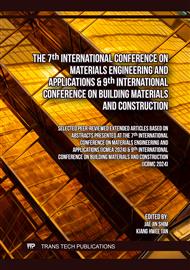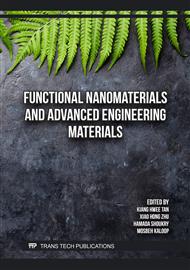[1]
H. Gay, T. Meynet, and J. Colombani, Local study of the corrosion kinetics of hardened Portland cement under acid attack, Cement and Concrete Research 90 (2016) 36–42, http://dx. doi.org/.
DOI: 10.1016/j.cemconres.2016.09.007
Google Scholar
[2]
S. Barbhuiya and D. Kumala, Behaviour of a Sustainable Concrete in Acidic Environment, Sustainability 9 (1556) (2017) 1-13.
DOI: 10.3390/su9091556
Google Scholar
[3]
S. Larreur-Cayol, A. Bertron, and G. Escadeillas, Degradation of cement-based materials by various organic acids in agro-industrial waste-waters, Cement and Concrete Research 41 (2011) 882–892.
DOI: 10.1016/j.cemconres.2011.04.007
Google Scholar
[4]
L. De Windt, A. Bertron, S. Larreur-Cayol, and G. Escadeillas, Interactions between hydrated cement paste and organic acids:Thermodynamic data and speciation modeling, Cement and Concrete Research 69 (2015) 25–36.
DOI: 10.1016/j.cemconres.2014.12.001
Google Scholar
[5]
Y. Senhadji, G. Escadeillas, M. Mouli, H. Khelafi, and Benosman, Influence of natural pozzolan, silica fume and limestone fine on strength, acid resistance and microstructure of mortar, Powder Technology 254 (2014) 314–323, http://dx.doi.org/10.1016/j.powtec.2014. 01.046.
DOI: 10.1016/j.powtec.2014.01.046
Google Scholar
[6]
M. Nazeer, K. Kapoor, and S.P. Singh, Strength, durability and microstructural investigations on pervious concrete made with fly ash and silica fume as supplementary cementitious materials, Journal of Building Engineering 69 (2023) 1-23, https://doi.org/10.1016/j.jobe. 2023.106275.
DOI: 10.1016/j.jobe.2023.106275
Google Scholar
[7]
A. Tripathy, and P. Kumar Acharya, Characterization of bagasse ash and its sustainable use in concrete as a supplementary binder – A review, Construction and Building Materials 322 (2022) 1-26.
DOI: 10.1016/j.conbuildmat.2022.126391
Google Scholar
[8]
ASTM Standard C267, Standard test methods for chemical resistance of mortars, grouts, and monolithic surfacing and polymer concretes.
DOI: 10.1520/c0267-97
Google Scholar
[9]
ASTM Standard C1898, Standard test methods for determining the chemical resistance of concrete products to acid attack.
DOI: 10.1520/c1898-20
Google Scholar
[10]
T. Nochaiya, T. Suriwong and P. Julphunthong, Acidic corrosion-abrasion resistance of concrete containing fly ash and silica fume for use as concrete floors in pig farm, Case Studies in Constr. Mater. 16 (2022) 1-15.
DOI: 10.1016/j.cscm.2022.e01010
Google Scholar
[11]
J. Witkowska-Dobrev, O. Szlachetka, M. Dohojda and K. Wi´sniewski, Effect of acetic acid on compressive strength and geometric texture of the surface of C20/25 class concrete, Sustainability 13 (2021) 1-16.
DOI: 10.3390/su13095136
Google Scholar
[12]
S. Barbhuiya and D. Kumala, Behaviour of a sustainable concrete in acidic environment, Sustainability 9 (2017) 1-13.
DOI: 10.3390/su9091556
Google Scholar
[13]
D. Kumar Nayak, P. Abhilash, R. Singh and V. Kumar, Fly ash for sustainable construction: A review of fly ash concrete and its beneficial use case studies, Clean. Mater. 6 (2022) 1-35.
DOI: 10.1016/j.clema.2022.100143
Google Scholar
[14]
E. Arif, M. Clark and N. Lake, Sugar cane bagasse ash from a high efficiency co-generation boiler: Applications in cement and mortar production, Const. Build. Mater. 128 (2016) 287-297.
DOI: 10.1016/j.conbuildmat.2016.10.091
Google Scholar



